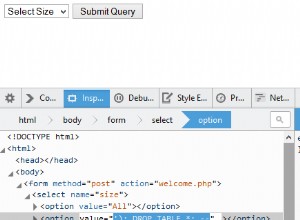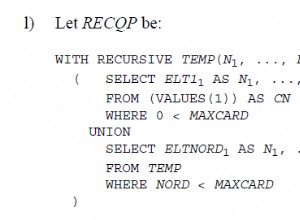Um die Funktion aus einer SQL-Abfrage aufzurufen, müssen Sie die Parameter wie im folgenden Beispiel in Ihren benutzerdefinierten Typ umwandeln.
select form_insertion(array[
cast(row('Form 1', 1, current_date, 1, current_date, 'This is form 1',
array[
cast(row('section-1', 'Section One', 1) as section),
cast(row('section-2', 'Section Two', 2) as section),
cast(row('section-3', 'Section Three', 3) as section)
]
) as form_details),
cast(row('Form 2', 2, current_date, 1, current_date, 'This is form 2',
array[
cast(row('section-2', 'Section Two', 2) as section),
cast(row('section-3', 'Section Three', 3) as section)
]
) as form_details),
cast(row('Form 3', 1, current_date, 1, current_date, 'This is form 3',
array[
cast(row('section-1', 'Section One', 1) as section),
cast(row('section-3', 'Section Three', 3) as section)
]
) as form_details)
])
Beachten Sie, dass PostgreSQL-Arrays keine .COUNT-Eigenschaft haben. Sie können ein Array nach Indexbereich mit array_upper Funktion:
for i IN 1..array_upper(formdetails, 1)
LOOP
-- your code here
END LOOP;
Seit PostgreSQL 9.1 können Sie die FOREACH-Anweisung verwenden, um das Array zu durchlaufen:
create or replace function form_insertion(formdetails form_details[])
returns varchar as $$
declare
detail form_details;
sec section;
begin
foreach detail in array formdetails
LOOP
RAISE NOTICE '%', detail.formName;
foreach sec in array detail.sections
LOOP
raise NOTICE '%', sec.sectionName;
END LOOP;
END LOOP;
return '';
end;$$
language plpgsql;




